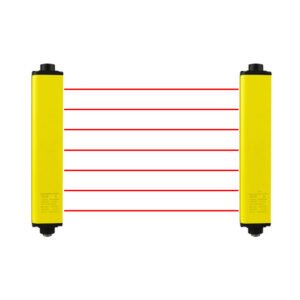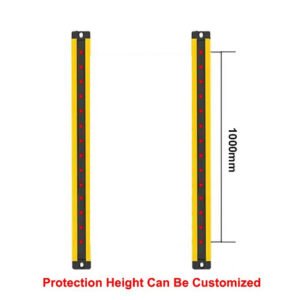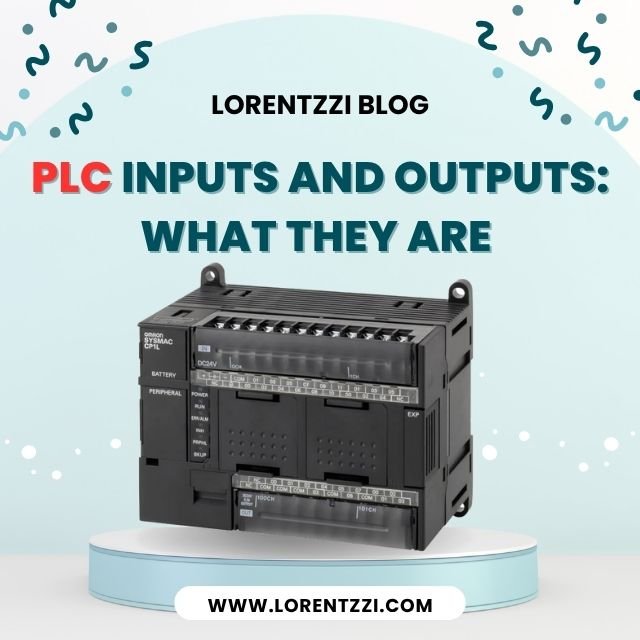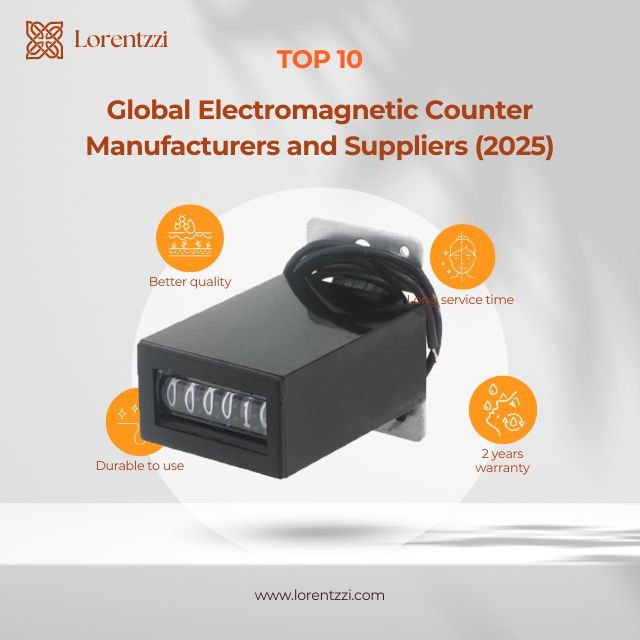Wraz z ciągłą poprawą świadomości społecznej w zakresie bezpieczeństwa, ludzie coraz częściej kładą nacisk na środki mające na celu zapewnienie bezpieczeństwa osobistego podczas obsługi maszyn. W ramach tego trendu, wprowadzenie i powszechne stosowanie kurtyny świetlne bezpieczeństwa znacznie podniosły poziom ochrony, zapewniając operatorom bardziej niezawodną gwarancję i skutecznie zmniejszając ryzyko przypadkowych obrażeń.
Ale czy wiesz, ile rodzajów kurtyn świetlnych bezpieczeństwa istnieje na świecie? Zgodnie z poziomem ochrony, istnieją dwa rodzaje kurtyn świetlnych bezpieczeństwa, typ 2 i typ 4, znane również jako kurtyny świetlne bezpieczeństwa kategorii 2 i kategorii 4. W tym artykule wyjaśnimy, czym one są i omówimy różnice między nimi.
Co to jest kurtyna świetlna bezpieczeństwa?

Kurtyna świetlna bezpieczeństwa jest bezdotykowym urządzeniem ochronnym służącym do ochrony ludzi przed niebezpiecznymi maszynami wykorzystującymi światło podczerwone lub źródło laserowe. Zasadniczo kurtyna świetlna składa się z nadajnika i odbiornika (lub reflektora). Wiele wiązek światła będzie emitowanych z nadajnika do odbiornika (lub reflektora), a gdy światło zostanie zablokowane przez obiekt, maszyna przestanie działać. Kurtyny świetlne bezpieczeństwa są szeroko stosowane w różnych maszynach, takich jak urządzenia hydrauliczne i windy, nożyce lub ciężkie prasy itp.
Co to jest kurtyna świetlna bezpieczeństwa typu 2?
Kurtyna świetlna bezpieczeństwa typu 2 to niedrogie fotoelektryczne urządzenie ochronne, które jest używane głównie do ochrony rąk, które bez Monitorowanie urządzeń zewnętrznych (EDM), Jest przeznaczony do umiarkowanych i niewielkich uszkodzeń maszyn.
Co to jest kurtyna świetlna bezpieczeństwa typu 4?

Kurtyna świetlna bezpieczeństwa typu 4 jest specjalnie zaprojektowany do zastosowań wymagających wysokiego poziomu ochrony. Kurtyny świetlne typu 4 mają Monitorowanie urządzeń zewnętrznych (EDM) funkcja. Może nie tylko wykrywać dłonie, ale także wykrywać dowolną część ludzkiego ciała, w tym palec, dłoń i ciało. Czujniki kurtyn świetlnych typu 4 mają bardzo szeroki zakres zastosowań, takich jak szybkie przenośniki taśmowe, przemysł spożywczy, przemysł farmaceutyczny itp.
Różnice między kurtynami bezpieczeństwa typu 2 i typu 4
Zgodnie z naszym doświadczeniem istnieją 4 różnice między czujnikami typu 2 i typu 4, wyjaśnimy je jeden po drugim, poniżej znajdują się szczegóły:
1. Różnice w kosztach
Ponieważ kurtyny bezpieczeństwa typu 4 mają wyższy poziom ochrony niż kurtyny typu 2 i mogą wykrywać mniejsze obiekty, komponenty stosowane w kurtynach typu 4 są znacznie bardziej zaawansowane, a dokładność wykrywania jest wyższa. W związku z tym koszt kurtyn bezpieczeństwa typu 4 jest wyższy niż kurtyn bezpieczeństwa typu 2.
2. Różnice w wydajności
Kurtyna świetlna bezpieczeństwa typu 4 ma dwa procesory CPU; kurtyna świetlna bezpieczeństwa typu 2 ma jeden procesor CPU.
3. Różnice w autodiagnostyce błędów
Kurtyna świetlna bezpieczeństwa typu 4 przeprowadza autodiagnostykę w celu sprawdzenia usterki oraz nadmiarowe wzajemne wykrywanie usterek wyższego poziomu itp. Kurtyna świetlna bezpieczeństwa typu 2 może przeprowadzać autodiagnostykę lub zewnętrzne okresowe testy w celu sprawdzenia usterki.
4. Różnice kąta przysłony


Kąt przysłony typu 2 wynosi 10 stopni, kąt przysłony typu 4 wynosi tylko 5 stopni zgodnie z opisami wideo SICK na Youtube (Zasoby: https://www.youtube.com/watch?v=aI_hDTHDw-4Ta różnica w kącie przysłony sprawia, że kurtyny typu 4 są bardziej precyzyjne niż kurtyny bezpieczeństwa typu 2.
5. Różnice w zakresie zastosowań
Kurtyny świetlne bezpieczeństwa typu 2 są odpowiednie do sytuacji lub maszyn o niskim ryzyku, takich jak uderzenie lub zadrapanie, przewrócenie, uszczypnięcie, ale nie zmiażdżenie, lub drobne skaleczenia i zadrapania, podczas gdy w przypadku sytuacji lub maszyn o wysokim ryzyku najlepszym wyborem są kurtyny świetlne bezpieczeństwa typu 4. Chociaż są one droższe, koszt ten jest znikomy w porównaniu z bezpieczeństwem życia operatora.
Wnioski
Mówiąc najprościej, istnieją dwa popularne typy kurtyn świetlnych bezpieczeństwa w zależności od różnic w poziomie ochrony, są to typ 2 i typ 4. Kurtyna świetlna typu 4 jest odpowiednia dla środowiska o wysokim poziomie ochrony, ale jej cena jest wysoka, podczas gdy kurtyna typu 2 jest tania i nadaje się do zastosowań o niskim ryzyku, ale jej cena jest niska.

Lorentzzi®, jako jeden z wiodących chińskich producentów producenci kurtyn świetlnych bezpieczeństwa, Możemy produkować zarówno kurtyny świetlne typu 2, jak i typu 4 o najlepszej jakości i umiarkowanej cenie. Skontaktuj się z nami teraz aby uzyskać naszą najnowszą ofertę na czujniki kurtyn świetlnych o różnych długościach chronionych.










